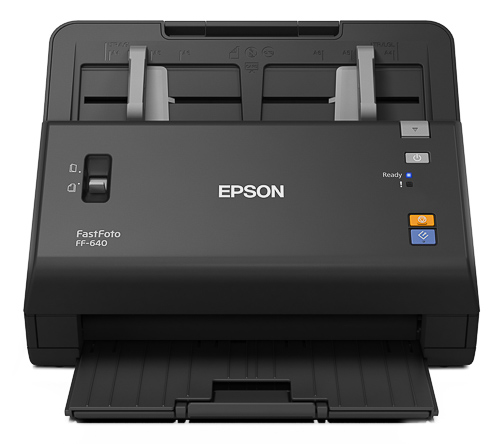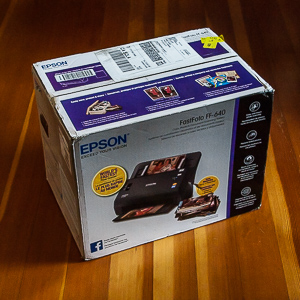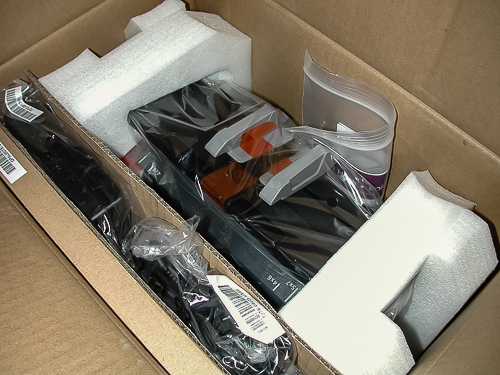C O N T E N T S
•
Photo Corners headlinesarchivemikepasini.com
![]()
A S C R A P B O O K O F S O L U T I O N S F O R T H E P H O T O G R A P H E R
![]()
Enhancing the enjoyment of taking pictures with news that matters, features that entertain and images that delight. Published frequently.
FastFoto: Arrival




21 November 2016
In the nearly 20 years we've been using and reviewing scanners we've heard from a lot of people who, newly retired, had assigned themselves the task of scanning their family photos. We always had bad news for them. They were already too old.
It takes, we would tell them, an hour to scan a roll of film. And just a little less to get through the usual 24 or 36 prints with a flatbed scanner if you don't have the negatives.
Then there's the editing. Turning negative scans into color-corrected positives, cleaning up dirt and scratches, restoring faded color.

Epson FastFoto. Compact and, yes, fast.
Some of that could be done in software at the time of the scan, we acknowledged, but it will slow down the scans.
Our usual recommendation was to farm the job out to a local lab. We were never fans of services that required shipping Valuable One-of-a-Kind Irreplaceable Originals anywhere (much less India, as HP's service required).
But there were then local labs with high speed scanners that could get the job done in one's lifetime. Not so much today. A handful of options remain but they all require shipping.
AN EPSON ALTERNATIVE
So when we met with Epson in September to look over its new FastFoto FF-640, we were excited. It was the first high-speed print scanner we'd seen designed for the home.
We wondered if, after 20 years, we finally had an answer for everyone who had ever wanted to digitize their analog family photos.
There was only one way to find out. Try it. So we arranged for a review unit with Epson and have been working with it for a while. This is the first part of a multipart review detailing our experience.
Note that the company launched an unusual public relations campaign for the FastFoto, offering a free unit to a limited number of people who agreed to review it on popular Web sites like Amazon. We aren't part of that campaign.
Like all of our reviews, this one represents our experience using the product for real work and, as such, we provide no guarantees (even to publish a review) to the manufacturer.
A PERSPECTIVE
Before we slice open the shipping box, we have to adjust our perspective on the problem of scanning your analog family photos.
They may span the entire history of the technology, after all.

The Box Arrives. With a new approach.
That means you may have black-and-white contact prints from the early 1900s made with a Kodak Brownie. And on the other extreme you could have carelessly processed one-hour prints from the 1970s made on linen-textured paper.
And while those early Kodak Brownies may not have seemed terrible impressive from a technological point of view, they did make large enough negatives for high quality contact prints. They certainly provided better image quality than the Instamatic 35mm enlargements of the 1960s or the Kodak Disc cameras of the 1970s.
Which were followed by the 35mm SLR craze, more of less, and one-hour photo processing. Early on, quite good quality was achieved with this technology but as it became popular that quality became uneven until, at the end in the 1990s, it nearly took all the fun out of taking photos with routinely terrible processing and printing.
So the quality of your original prints will vary dramatically over the years.
The years are not kind to photographic dyes either. Even hidden away in albums, colors shift. Your oldest black-and-white contact prints will have held up much better.
Finally, it has to be said that the original negative image is the thing to scan where quality is an issue. Nothing surpasses it and the print itself is a generation away. We'll publish comparisons of a negative scan using the OpticFilm 135, a flatbed scan using the CanoScan 9000F and a print scan using the Epson FastFoto to demonstrate the differences.
But, as something of a postscript to this perspective, you don't always need a high quality scan. Sometimes you just need a thumbnail. The FastFoto will do better than that, we've found. And nothing really prevents you from doing what we always recommended. And that is to spend some time with your favorite images on a high quality scan.
If (Postscript Number Two) you're wondering if you can't just to this with your phone, the answer is that you can (and we have). Google's new PhotoScan can even help you get slightly better results than winging it with the built-in Camera app. But you won't get anywhere near the quality of a scan. So we tend to think of these captures as souvenirs rather than scans.
HIGHLIGHTS
Although we pointed these out in our news story, we'll save you a few clicks by repeating the highlights of the speedy print scanner here:
- Fast Photo Scanning of one photo/second at 300 dpi
- High-quality scans up to 600 dpi
- Restore, save organize and share images
- Smart Photo Fix Technology with red-eye removal and color enhancement
- Duplex scanning captures both the image and handwritten notes on the back in a single scan
- Special handling sheet, custom rollers and paper path to accommodate fragile photos
- Perfect Picture Imaging System optimizes image quality across printers, projectors and scanners
- Scan and save documents and memorabilia as fast as 45 ppm/90 ipm
SPECIFICATIONS
Specifications for the FastFoto include:
EPSON FASTFOTO SCANNER Scanner Features Type Sheet-fed, one-pass duplex color scanner Sensor 600 dpi, one-line CISM Optical Resolution 600 dpi with Micro Step Drive Output Resolution 75 to 1,200 dpi Effective Pixels 5,100 x 8,400 pixels Color 48-bit internal
24-bit externalMonochrome 1-bit output bit depth Automatic Document Feeder 30 photos with thickness < 0.23mm
80 documentsPaper Size 2x2-inches to 8.5x120-inches Photo Size Wallet, 4x6, 5x7, 8x10, Panoramaic Carrier Sheet 8.5x11 maximum Paper Weight Photo thickness: < 0.3mm
Document: 40-210 g/mLight Source 3-color RGB LED 4x6 Photo Scan Speed 60 ppm/120 ipm at 300 dpi
33 ppm/66 ipm at 600 dipDocument Scan Speed 45 ppm/90 ipm at 300 dpi
33 ppm/66 ipm at 600 dpiGeneral Features System Requirements Mac OS 10.9.x to 10.11.x
Windows 8/8.1/10Connectivity Hi-Speed USB 2.0 Reliability Daily duty cycle of 4,500 sheets Operating Temperature 41°F to 95°F Humidity 10 to 80 percent Power Consumption Operating: 42.0 W, Ready 8.0 W, Sleep 1.6 W, Off 0.4 W Bundled Software Epson Scan, Document Capture Software, Epson FastFoto with Smart Photo Fix, ABBYY FineReader OCR Driver Support TWAIN and Mac Eco Features RoHS compliant
Recyclable product
Epson America, Inc. is a SmartWay Transport PartnerCountry of Origin China Dimensions 11.8 x 8.7 x 8.1 inches Weight 8.8 lbs. Warranty One year, U.S. and Canada IN THE BOX
The $650 FastFoto arrived in a compact box whose small size was made possible by engineering the feed table as a separate piece.
Here's what we found inside that box:
- The FastFoto scanner body
- The feed table
- A power brick
- A power cable
- A USB cable
- Two microfiber cloths
- A carrier sheet
- A Start Here poster
Our box also contained a plastic box containing a handful or so of sample prints to scan. They were pre-digital photo prints, including some old black-and whites that looked like the kind of print you can pick up at some flea market. We suspect they are included only with review unit, though. Because you'll certainly have your own.
The carrier sheet is designed for fragile prints, which you can drop onto the sheet so it takes the pressure of the rollers off the print. It isn't typically necessary.

Inside. The thin cardboard on the left contains the carrier sheet, the power brick and cables are to the right of it and the feed table and scanner are held securely by the Styrofoam.
NOT IN THE BOX
What we didn't find in the box was a CD with any software or a manual of any kind. That's really just as well, though, because by obliging you to go to the Epson site to download the software, you'll get the latest version. You'll also be able to optionally download OCR and document capture software included with your purchase.
There's no hint in these materials until you read the User's Guide but the FastFoto does require periodic replacement of its rollers. That's a $50 expense incurred every 120,000 scans, the company estimates. A counter in the software itself will remind you when it's time to do it.
We'll take a moment to applaud Epson for making replacement rollers available and providing that counter. We've used many products with rollers from typewriters to Baumfolders to presses to laser printers and more. The rollers do wear out and cause performance problems when they do. By then it can be difficult to find replacements (we've rolled tape around some to bulk them up) so it's nice to see Epson provide this information and a solution up front.
Remember that your originals are fed through the scanner by means of those rollers. You'll want to keep them clean and in good condition to avoid damaging your prints.
And on that cleanliness note, Epson recommends using the included microfiber cloths (which can easily be washed by hand) to clean the rollers and glass every not and then -- and preferable before each session. Prints can leave paper dust in their tracks, after all.
We suspect the microfibers are not an ideal solution, though. Shipping prohibitions probably prevented the company from including a can of compressed air, which is the method we prefer for cleaning things like this (including prints and negatives). It's no-touch safe.
NEXT
In our next installation of this multipart review, we'll describe the installation process.
(Editor's Note: This is the first part of a multi-part review of the Epson FastFoto FF-640. Links to the other stories are in the main table of contents at the top right of each story.)